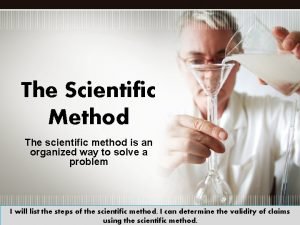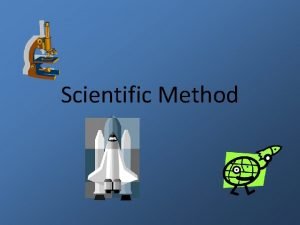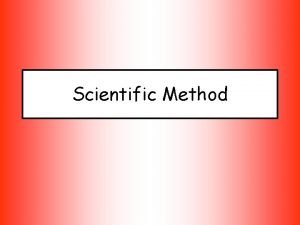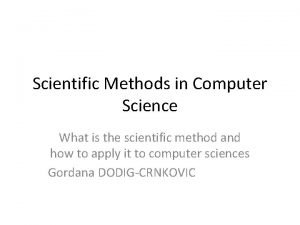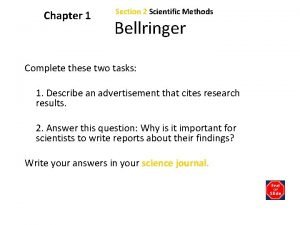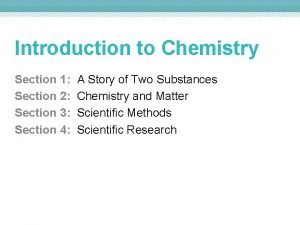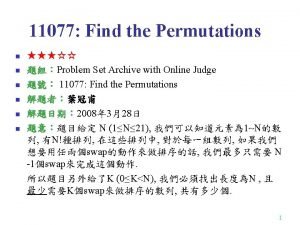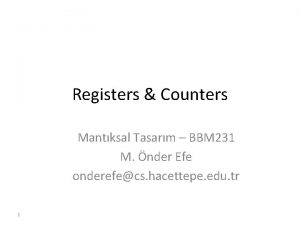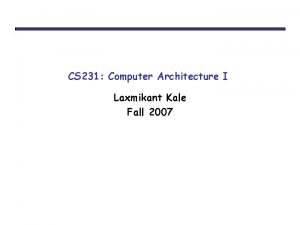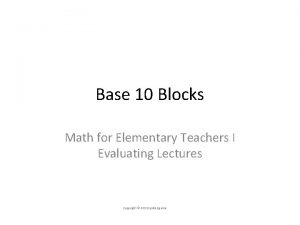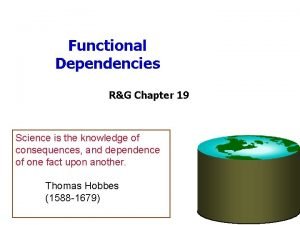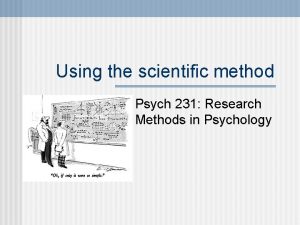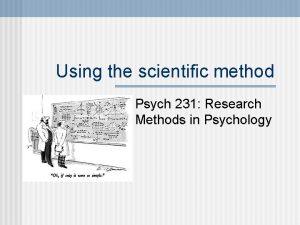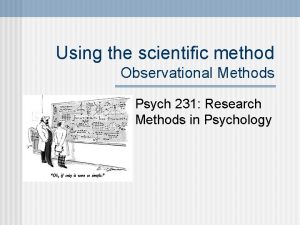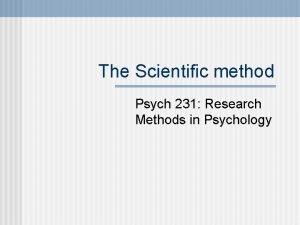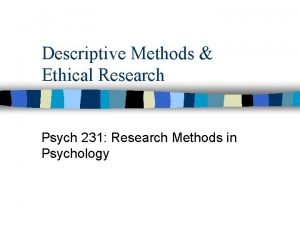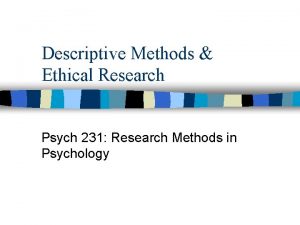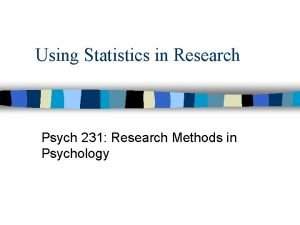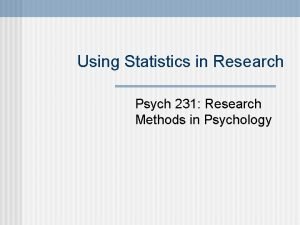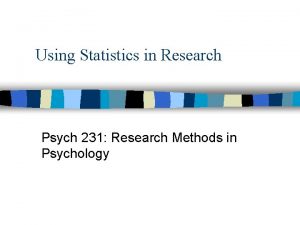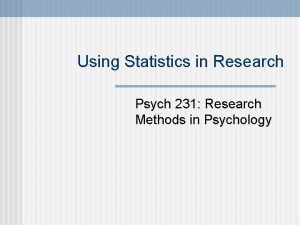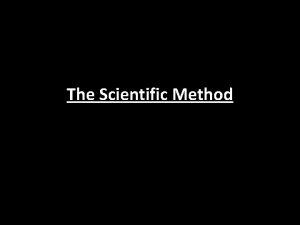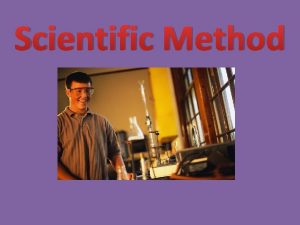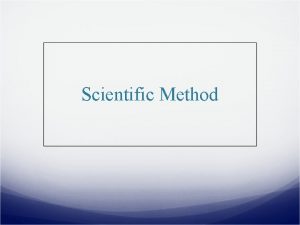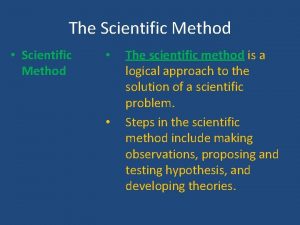Using the scientific method Psych 231 Research Methods





















- Slides: 21

Using the scientific method Psych 231: Research Methods in Psychology

n This week’s labs - Library Labs: n n Milner rooms 164 d or 213 c (for the psyc. INFO lecture) 3 rd floor (to meet with the GAs) Check out Sharon’s library page (link on syllabus too) Next week’s labs: n Download and read the Assefi & Garry (2003) article before labs Lab Announcements

n Claim: People perform best with a good night of sleep. • To begin to answer it we’ve got to FOCUS the idea • Break the general idea down into smaller more specific ideas • Develop theories as to how & why • EVALUATE the idea (e. g. , the ROT test) • TEST the idea: using research methods to test parts of theories (hypotheses) Conducting Research: An example

n Claim: People perform best with a good night of sleep. n Focusing the idea n What do we mean by performance? • Academic performance? • Physical performance? n What do we mean by “good night sleep”? • 8 hrs? , Uninterrupted? , 3 hours of REM? n What is the underlying theory? • e. g. , consolidation of memories happen during REM sleep, so getting more REM sleep should lead to better recall Conducting Research: An example

n n Claim: People perform best with a good night of sleep. Evaluating the idea (ROT) n Can we replicate the research, do we get similar results? n n Answer may depend on how you choose to make your observations (your research methods) How do we observe performance? How do we observe good sleep? • Recall tests, recognition tests, “brain waves, ” , , , n Are our predictions testable? Conducting Research: An example

n n Claim: People perform best with a good night of sleep. How might we go about trying to test this claim? n n n What are things (variables) of interest? What is the hypothesized relationship between these variables? How should we test it? n n How do we observe the behavior? What research design should we use? Conducting Research: An example

n Observational approaches: How do we observe the behaviors of interest? n n n Naturalistic observation Direct Participant observation Observation Survey & interviews Archival data Systematic (contrived) observation Observation without manipulation General research approaches

n Naturalistic Observation: Observation and description of behaviors within a natural setting n n Jane Goodall n n High external validity Good for behaviors that don’t occur (as well) in more controlled settings Often a first step in the research project Can be difficult to do well n n n Hard not to influence things (reactivity effect) Takes a long time Need multiple observers to agree Dian Fossey Observational Methods

n Participant Observation: The researcher engages in the same behaviors as those being observed n n May allow observation of behaviors not normally accessible to outside observation Internal perspective from direct participation • But could lead to loss of objectivity n Potential for contamination by observer Observational Methods

n Survey methods: Questionnaires and interviews that ask people to provide information about themselves • Widely used methodology • Best way to collect some kinds of information: • Descriptive, behavioral, and preferential • e. g. , demographic information, recreational behavior, and attitudes • Large amounts of data can be collected quickly with relatively little cost (effort, time, etc. ) • But they’re often not as “cheap” as you may think • Done correctly, can be a very difficult method Observational Methods

n Archival data: Rather than making direct observations, researcher examines existing public or private records n n If the appropriate existing records can be found, no need for data collection Data set may be more extensive than what you could collect yourself • However, you are limited to the data that exists, may be no way to collect follow-up data n Data may be of observations that you cannot (ethically) collect or manipulate • E. g. , murder rates, who marries whom, etc. n Word of caution: be aware of how and where the data were collected Observational Methods

n Advantages n n n Complex patterns of behavior in particular settings Useful when little is known about the subject of study May learn about something that never would have thought of looking at experimentally n Disadvantages n n Causality is a problem Threats to internal validity because of lack of control • Every confound is a threat • Lots of alternative explanations n n Directionality of the relationship isn’t known Sometimes the results are not reproducible Observation without manipulation

n Systematic (Contrived Observation): The observer sets up the situation that is observed n n Observations of one or more specific variables made in a precisely defined setting Much less global than naturalistic observations Often takes less time However, since it isn’t a natural setting, the behavior may be changed Observational Methods

n Case studies n n Correlational n n Looking for a co-occurrence relationship between two (or more) variables Quasi-experimental n n Intensive study of a small set of individuals and their behaviors Experimental designs with one or more non-random variables Experimental n Investigating the cause-and-effect relationship between two (or more) variables through the manipulation of variables Types of research designs

n Intensive study of a single person, a very traditional method n Typically an interesting (and often rare) case n Phineas Gage n n Sept 13, 1848 Explosion propelled a railroad tamping rod through his brain This view has a number of disadvantages n n There may be poor generalizabilty There are typically a number of possible confounds and alternative explanations Descriptive: Case Histories

n n Measure two (or more) variables for each individual to see if the variables co-occur (suggesting that they are related) Used for: n n Predictions Reliability and Validity Evaluating theories Problems: Can’t make casual claims Correlational Methods

We’d like to say: n variable X --causes--> variable Y To be able to do this: n § § There must be co-variation between the two variables The causal variable must come first § Directionality problem • Happy people sleep well • § Or is it that sleeping well when you’re happy? Need to eliminate plausible alternative explanations § Third variable problem • Do Storks bring babies? • A study reported a strong positive correlation between number of babies and stork sightings Causal claims

Theory 1: Storks deliver babies

Theory 2: Underlying third variable

n n Manipulating and controlling variables in laboratory experiments Must have a comparison n At least two groups (often more) that get compared One groups serves as a control for the other group Variables n n n Independent variable - the variable that is manipulated Dependent variable - the variable that is measured Control variables - held constant for all participants in the experiment The experimental method

n Advantages n n n Precise control possible Precise measurement possible Theory testing possible Can make causal claims Disadvantages n n Artificial situations may restrict generalization to “real world” Complex behaviors may be difficult to measure The experimental method
 Scientific inquiry vs scientific method
Scientific inquiry vs scientific method Examples of problems using scientific method
Examples of problems using scientific method Steps of scientific method
Steps of scientific method Solving a problem using scientific method
Solving a problem using scientific method Wax pattern fabrication pdf
Wax pattern fabrication pdf Modified euler's method formula
Modified euler's method formula Scientific methods in computer science
Scientific methods in computer science Chapter 1 section 2 scientific methods answer key
Chapter 1 section 2 scientific methods answer key Introduction to chemistry section 3 scientific methods
Introduction to chemistry section 3 scientific methods How is a scientific law different from a scientific theory?
How is a scientific law different from a scientific theory? Acf 231
Acf 231 Article 231 of the treaty of versailles
Article 231 of the treaty of versailles 123 132 213 231 312 321
123 132 213 231 312 321 Pa msu
Pa msu Decreto legislativo n. 231/2007
Decreto legislativo n. 231/2007 Eis que o anjo proclamou
Eis que o anjo proclamou Gezang 231
Gezang 231 Ring counter verilog
Ring counter verilog Cs 231
Cs 231 Cost 231 walfisch-ikegami model
Cost 231 walfisch-ikegami model Draw 231 with base ten blocks
Draw 231 with base ten blocks 040 231 3666
040 231 3666

